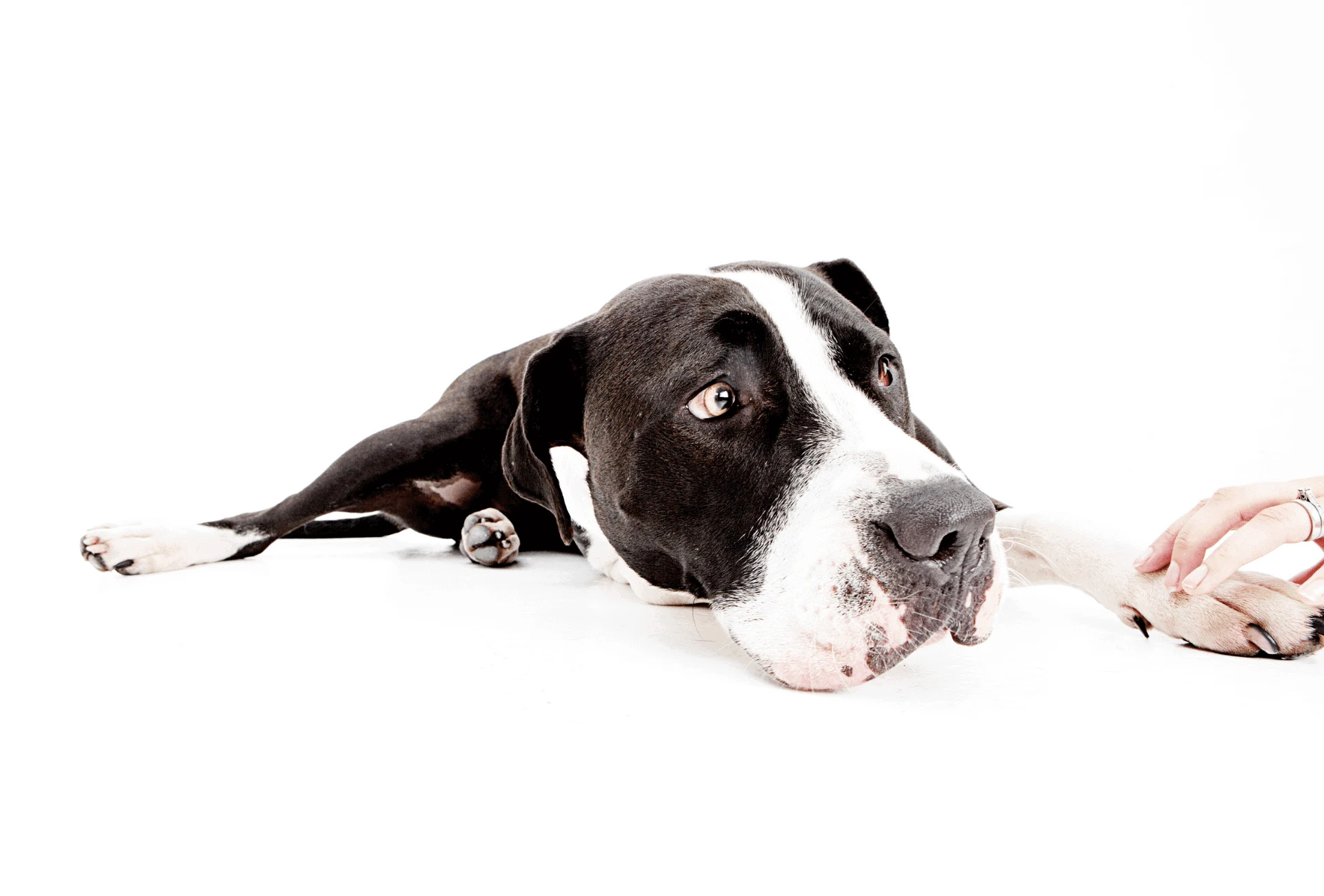Humans do things like crying or ‘moping around’ when we are sad or depressed.
Children will actually shake sometimes or throw tantrums when they are sad.
In many cases, we just assume that canines have the same set and spectrum of emotions like we do.
Science has proven that dogs can’t be spiteful, for example, and yet many people believe their dog relieved himself on the floor on purpose.
So, can dogs sense sadness? Do they know when we are feeling depressed, sorrowful, dejected, or downhearted?
Or are we just anthropomorphizing our dogs?
Can Dogs Sense When You Are Sad?
Yes, dogs sense when you are sad and are usually very aware of most other emotions.
They can tell when we humans aren’t feeling optimistic, out of sorts, or downright miserable.
It isn’t some mystical aura of emotion we give off or a strange and mysterious mental connection you share with your dog.
There is no all-powerful magic that allows emotions to flow from human owner to dog either.
Still, our dogs can absolutely sense when we are sad, often better than we can sense the sadness in each other. But how do they do it then?
Our dogs sense sadness because they can sense the changes that occur because of it.
The following statement is probably more accurate: Our dogs can sense change (not emotion).
Our Dogs Read Body Language
Unlike you or I, dogs don’t talk in a spoken language to each other.
They will send vocal signals through barks, whines, yips, snarls, or yelps, and wolves do use an intricate system of howling to express various things.
However, these sounds still aren’t used as a canine’s main form of communication.
Dogs communicate mainly through a set of visual cues. In fact, their bodies are designed for it.
A dog’s tail acts as an antenna, immediately letting other animals know their state of mind based on tail position.
His ears, eyes, posture, and even a dog’s fur itself can be used to send signals.
If you’re curious exactly what your dog’s tail positioning means, head on over to ‘Dog Tail Down or Up And Stiff? Dog Tail Meaning Explained!’.
A careful observer will be able to tell exactly how a dog is feeling about any given situation in the fraction of a split second it takes signals to travel along our optic nerves to the visual cortex in our brains for interpretation.
To most dog owners, this happens as naturally as breathing.
We rarely put any conscious thought into it at all.
If we can learn to easily read a dog’s visual communication so well, how natural do you think it is for the dogs themselves?
They’re constantly observing.

You might say dogs know their owners better than they know themselves.
Your dog is constantly watching you for even the slightest visual change.
They are always reading our emotions, constantly tracking our movements.
If there is anything out of the ordinary, or we carry ourselves differently somehow, they want to know what it means for them.
If we are showing signs of anger or frustration with this video game or after that phone call, our dogs almost always know to keep their distance.
If you have a gamer friend, for example, take note of the ways his dog reacts.
They also follow our gestures if we point somewhere and there have been experiments where seemingly more resourceful wolves lost against domesticated dogs since they knew that following the human’s finger = reward.
Pheromones of sadness.
We all know dogs enjoy one of the most powerful senses of smell of all land animals.
The few animals with stronger olfactory senses will never be capable of a dog’s empathy, so they might as well enjoy the strongest sense of smell.
Many scientists think we might secrete pheromones depending on our emotional mindset.
Whereas our tears are odorless to us, a dog will absolutely be able to detect the sugar and sodium in them.
Not only can dogs easily detect subtle changes in the visual cues we give off, but they can also probably smell certain changes in emotion.
There’s a reason why people want to hire animal communicators to lay a bridge to their dogs.
However, reading their mind is simple than you might think.
How Do Dogs Comfort You When You Are Sad?
Imagine yourself sobbing or hunched over in the kind of submissive posture we display when depressed.
Your furry little cuddle buddy notices this change in your behavior and lies down next to you on the couch.
Simply by sitting there with us, perhaps offering the swipe of a cool, wet tongue, our cherished companions are offering the much-needed comfort that companionship provides.
Just like dogs, we humans thrive on companionship (most of us).
The mere presence of another living empathetic creature we can cuddle up next to provides a strong sense of security.
We want to offer our dogs attention when they approach, especially when we are sad.
That feeling of loving devotion helps console us in our times of sadness.
“It’s possible that dogs learn to approach crying people because their owners give them affection when they do, the researchers wrote.”
LiveScience – Canine Comfort: Do Dogs Know When You’re Sad?
This is a slightly more complicated question, and the answer would depend on how each person reacts to sadness.
Your dog might become upset when you cry, but not sad from a human’s perspective.
We have learned a lot about canine social behavior.
Highly educated biologists have spent endless hours detailing the countless minute habits of our canine friends.
That being said, we can make a very general determination.
Dogs will react to our emotions based on what they get out of them.
Keep an eye out for negative emotions.
For example, certain people might become very confrontational, screaming, or displaying signs of physical aggression when extremely sad.
These intense human reactions are going to give dogs anxiety, causing them to avoid us for fear of our own outward aggression.
Your dog would absolutely become upset in these situations.
Consider the example of a screaming match with a significant other, causing intense crying.
Many dogs become extremely anxious, even to the point of visibly shaking, when owners scream at each other.
They’ve likely learned to fear potential outcomes, such as the owner venting frustration by screaming at them.
Sadly, some dogs have simply learned to fear their owner’s emotional imbalances.
They’ll either try to escape the situation, make themselves seem as small and non-threatening as possible, or react defensively themselves.
What behavioral changes do you see in your dog when you are feeling sad or depressed, as opposed to happy and cheerful?
So, canines do learn to avoid angry people. How good for them.
They can be defensive of their human parent.
Your dog might also see physical vulnerability in your sadness.
Thinking their human family member could be facing a potential threat to their well-being, your pet could show aggression to the instigator.
Have you ever either noticed your own dog or heard of a friend’s dog growl as one human yelled at another?

Beneficial companionship is also possible.
Consider the opposite scenario.
You thrive off your dog’s companionship, offering plenty of attention, pets, scratches, and praise.
Your signs of sadness would let your dog know he has something to gain from your companionship.
He would want to be around you, and wouldn’t become upset at all when you cry.
Do you become very depressed when you cry, closing yourself off away from your dog?
Your dog would be upset because he knows he is about to become an afterthought.
With all things considered, your dog becomes upset when you cry because it doesn’t mean good outcomes for him.
If you only want the absolute best relationship with your furry companion, check out ‘The Right Way to Bond With Your Dog’.
Do Dogs Reflect their Owner’s Emotions?
You already know dogs are able to read our emotions or reactions extremely well.
They chose how to judge a certain situation based on how we seem to perceive it.
If we seem scared, shaky, or frightened, our dogs will automatically know something is wrong.
For example, if something seems to have us visibly frightened, they will know something isn’t safe and either become anxious or defensive.
Dogs don’t always reflect our emotions as much as respond to our emotions.
But I’ve Seen My Dog Cry!
You might have actually seen tears from around your dog’s eyes.
You probably thought this was either a spectacular show of empathy or extremely sad.
Posts of crying mother dogs are especially popular on social media outlets for the gut-wrenching emotions they make you feel.
Not even the author always knows these are misleading.
Though it might be disappointing, dogs are in fact physically incapable of shedding an emotional waterfall, no matter how depressed or anxious they may be.
In a physiological sense, their bodies just don’t work this way.
Dogs don’t express sadness through tears, but they do have lacrimal glands that produce tears as a method of lubrication, just like us.
A normally functioning canine tear duct shouldn’t produce so much moisture they appear to cry.
To veterinarians, epiphora describes an overflow of tears from the eyes and can be associated with several possible eye problems in dogs.
According to VCA hospitals “The most common cause of insufficient tear drainage is a blockage of the nasolacrimal ducts or poor eyelid function due to a deformity”.
So look out for your canine if he seems to cry.
Can Dogs Sense Grief?
Dogs are very much able to notice grief through the body language cues we give off, changes in tone of voice, and smells only a dog would notice.
Our dogs can usually tell if there is a big problem or not based on how we react to it.
If we are grieving the loss of a loved one that also meant a lot to our dog, for example, studies show they won’t just sense our grief but grieve themselves.
This is a drastic change in their lives because they also just lost someone very important to them.
This makes perfect sense from a psychological perspective.
The dog also feels distressed towards this undesirable change that means discomfort (or less comfort, uncomfortable anxiety) to them.
Dogs mourning alongside their owners is a common denominator and not all too rare sight (although we all hope that it’ll never come to that).
Can we hide our grief?
Only humans that are extremely good at internalizing emotions are able to mask grief from their dogs.
If you’re able to express a consistently happy, joyful persona on the outside while sad or depressed on the inside, your dog probably won’t know the difference.
You would have to be very good at maintaining a visual body language constant, or your dog will detect a change and know something is up.
Any change in behavior will alert our dogs to potential problems.
We don’t yet know the full extent of our dog’s ability to smell changes in our body chemistry.
Dogs are being trained in medical settings to ‘smell’ abnormalities, alerting physicians faster than human detection methods, so this is a natural conclusion.
“Dogs are most famously known for detecting cancer. They can be trained to sniff out a variety of types including skin cancer, breast cancer, and bladder cancer using samples from known cancer patients and people without cancer.”
UAR
The age-old expression we’ve all heard ‘The dog can smell your fear’ probably has more truth to it than we realize.
A dog’s nose is really quite amazing.
Next time you have a heated argument or you’re grieving, think about the implications this can have for your dog as they might share your pain unintentionally.
Dogs are sensitive beings and a real treasure we should preserve by trying to keep them happy as much of the time as possible.
